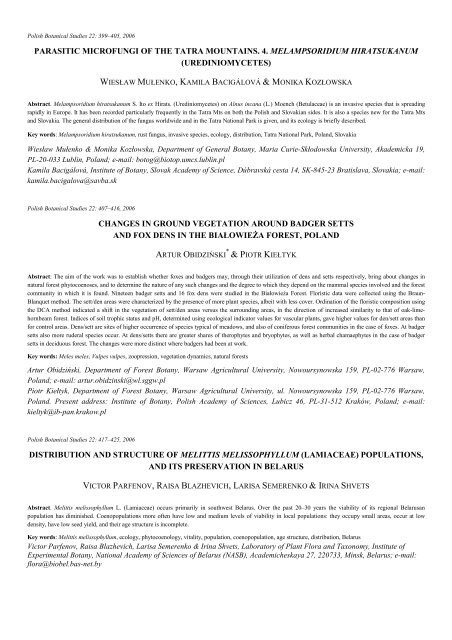Polish Botanical Studies 22 (2006)
Polish Botanical Studies 22 (2006)
Polish Botanical Studies 22 (2006)
You also want an ePaper? Increase the reach of your titles
YUMPU automatically turns print PDFs into web optimized ePapers that Google loves.
<strong>Polish</strong> <strong>Botanical</strong> <strong>Studies</strong> <strong>22</strong>: 399–405, <strong>2006</strong><br />
PARASITIC MICROFUNGI OF THE TATRA MOUNTAINS. 4. MELAMPSORIDIUM HIRATSUKANUM<br />
(UREDINIOMYCETES)<br />
WIESŁAW MUŁENKO, KAMILA BACIGÁLOVÁ & MONIKA KOZŁOWSKA<br />
Abstract. Melampsoridium hiratsukanum S. Ito ex Hirats. (Urediniomycetes) on Alnus incana (L.) Moench (Betulaceae) is an invasive species that is spreading<br />
rapidly in Europe. It has been recorded particularly frequently in the Tatra Mts on both the <strong>Polish</strong> and Slovakian sides. It is also a species new for the Tatra Mts<br />
and Slovakia. The general distribution of the fungus worldwide and in the Tatra National Park is given, and its ecology is briefly described.<br />
Key words: Melampsoridium hiratsukanum, rust fungus, invasive species, ecology, distribution, Tatra National Park, Poland, Slovakia<br />
Wiesław Mułenko & Monika Kozłowska, Department of General Botany, Maria Curie-Skłodowska University, Akademicka 19,<br />
PL-20-033 Lublin, Poland; e-mail: botog@biotop.umcs.lublin.pl<br />
Kamila Bacigálová, Institute of Botany, Slovak Academy of Science, Dúbravská cesta 14, SK-845-23 Bratislava, Slovakia; e-mail:<br />
kamila.bacigalova@savba.sk<br />
<strong>Polish</strong> <strong>Botanical</strong> <strong>Studies</strong> <strong>22</strong>: 407–416, <strong>2006</strong><br />
CHANGES IN GROUND VEGETATION AROUND BADGER SETTS<br />
AND FOX DENS IN THE BIAŁOWIEśA FOREST, POLAND<br />
ARTUR OBIDZIŃSKI * & PIOTR KIEŁTYK<br />
Abstract: The aim of the work was to establish whether foxes and badgers may, through their utilization of dens and setts respectively, bring about changes in<br />
natural forest phytocoenoses, and to determine the nature of any such changes and the degree to which they depend on the mammal species involved and the forest<br />
community in which it is found. Nineteen badger setts and 16 fox dens were studied in the BiałowieŜa Forest. Floristic data were collected using the Braun-<br />
Blanquet method. The sett/den areas were characterized by the presence of more plant species, albeit with less cover. Ordination of the floristic composition using<br />
the DCA method indicated a shift in the vegetation of sett/den areas versus the surrounding areas, in the direction of increased similarity to that of oak-limehornbeam<br />
forest. Indices of soil trophic status and pH, determined using ecological indicator values for vascular plants, gave higher values for den/sett areas than<br />
for control areas. Dens/sett are sites of higher occurrence of species typical of meadows, and also of coniferous forest communities in the case of foxes. At badger<br />
setts also more ruderal species occur. At dens/setts there are greater shares of therophytes and bryophytes, as well as herbal chamaephytes in the case of badger<br />
setts in deciduous forest. The changes were more distinct where badgers had been at work.<br />
Key words: Meles meles, Vulpes vulpes, zoopression, vegetation dynamics, natural forests<br />
Artur Obidziński, Department of Forest Botany, Warsaw Agricultural University, Nowoursynowska 159, PL-02-776 Warsaw,<br />
Poland; e-mail: artur.obidzinski@wl.sggw.pl<br />
Piotr Kiełtyk, Department of Forest Botany, Warsaw Agricultural University, ul. Nowoursynowska 159, PL-02-776 Warsaw,<br />
Poland. Present address: Institute of Botany, <strong>Polish</strong> Academy of Sciences, Lubicz 46, PL-31-512 Kraków, Poland; e-mail:<br />
kieltyk@ib-pan.krakow.pl<br />
<strong>Polish</strong> <strong>Botanical</strong> <strong>Studies</strong> <strong>22</strong>: 417–425, <strong>2006</strong><br />
DISTRIBUTION AND STRUCTURE OF MELITTIS MELISSOPHYLLUM (LAMIACEAE) POPULATIONS,<br />
AND ITS PRESERVATION IN BELARUS<br />
VICTOR PARFENOV, RAISA BLAZHEVICH, LARISA SEMERENKO & IRINA SHVETS<br />
Abstract. Melittis melissophyllum L. (Lamiaceae) occurs primarily in southwest Belarus. Over the past 20–30 years the viability of its regional Belarusan<br />
population has diminished. Coenopopulations more often have low and medium levels of viability in local populations: they occupy small areas, occur at low<br />
density, have low seed yield, and their age structure is incomplete.<br />
Key words: Melittis melissophyllum, ecology, phytocoenology, vitality, population, coenopopulation, age structure, distribution, Belarus<br />
Victor Parfenov, Raisa Blazhevich, Larisa Semerenko & Irina Shvets, Laboratory of Plant Flora and Taxonomy, Institute of<br />
Experimental Botany, National Academy of Sciences of Belarus (NASB), Academicheskaya 27, <strong>22</strong>0733, Minsk, Belarus; e-mail:<br />
flora@biobel.bas-net.by
















